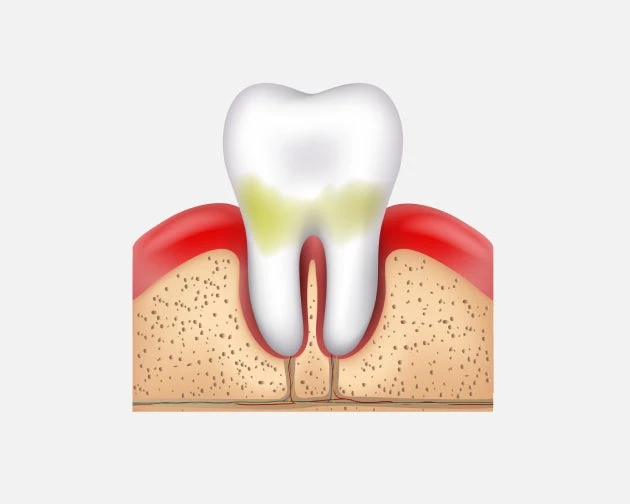
Maintain a Balanced Diet
Eat a diet rich in fruits, vegetables, and whole grains. Limit sugar as it can contribute to plaque formation. It’s also important to stay properly hydrated to keep your mouth moist.
While common, periodontal disease is an advanced form of gum disease. Let’s take a look at its root causes and options for treatment.
‘What is periodontal disease?’ is a question that has more than one simple answer. It’s a chronic inflammatory condition that impacts the gums and the supporting structures of the teeth.
Caused by a buildup of bacteria that affects the tissues in your mouth, periodontal disease is the leading cause of tooth loss in adults. Symptoms can range from mild to severe depending on how bad the infection is.
The main forms of periodontal disease are:

The earliest stage of gum disease is when the gums are inflamed and can bleed during brushing and flossing. If caught early on, gingivitis is reversible with the right treatment.

During this stage, patients experience minor bone loss. The gums begin to recede and form tiny pockets around the teeth.

This is most advanced stage. Teeth can become loose, and possibly fall out due to the extent of the damage.

Gum recession increases and causes deeper pockets around the teeth. This can lead to increased damage to the jawbone and gums.
Knowing what is periodontal disease and not seeking appropriate treatment can put you at increased risk for illness. If you’re struggling with gum disease, you may be at a higher risk of life-threatening conditions, including:
Stroke
Bone Loss
Heart Disease
Respiratory Infection
Cancer
Diabetes
Other Complications
As you continue to read about the answer to the question ‘What is periodontal disease?” you may wonder about periodontal disease symptoms and signs of early periodontal disease.
Periodontal disease symptoms are characterized by inflammation of the gums. Here are some common signs to watch out for:
Red, swollen, tender, or sensitive gums
Bleeding gums
Bad breath
Receding gums
Pockets between teeth and gums
Changes in bite or tooth alignment
Pus or sores
It’s important to remember that periodontal disease symptoms vary from person to person. Not all individuals will experience all the symptoms above. If you’re experiencing any early periodontal disease symptoms, it’s important to seek treatment to make an accurate diagnosis. Early detection and treatment are important to prevent further damage and decrease risk of associated illnesses.
You may find yourself asking “What is periodontal disease treatment and what does it look like?” Treatment for periodontal disease often depends on the severity of the condition. Early periodontal disease can often be managed with improved oral hygiene, including regular brushing, flossing, and professional dental cleaning. In more advanced cases additional treatment may be necessary, including:
Deep cleaning to remove plaque and tartar from the teeth and gums to help the gums heal and reattach to the tooth.
Removes tartar and plaque from harder-to-reach areas and makes it easier to keep your teeth clean.
Rebuilds or reshapes soft tissue and bone to help hold loose teeth in place and protect the tooth’s tooth from sensitivity and decay.
Minimally invasive surgery to treat and regenerate soft tissue and bone. Gently reduce bacteria and inflammation without incisions or stitches to create a clean environment for healing.
Preventing gum disease involves practicing good oral hygiene, including:

Brush your teeth at least twice a day for two minutes each time, and floss daily. Be sure to brush along the gum line to help remove plaque and bacteria.

Eat a diet rich in fruits, vegetables, and whole grains. Limit sugar as it can contribute to plaque formation. It’s also important to stay properly hydrated to keep your mouth moist.

Smoking and chewing tobacco can increase your risk of gum disease. For optimal oral health, it’s best to stop or reduce consumption of tobacco.

Schedule regular check-ups and professional cleanings with your dental provider. A dental professional can identify early symptoms of periodontal disease.
ClearChoice Dental Implant Centers provides high quality dental implants to replace teeth lost due to periodontal disease. Dental implants consist of an artificial tooth root, surgically placed into the jawbone. The implant provides a stable foundation for attaching the dental crown, which restores the appearance and function of missing teeth caused by gum disease.
While dental implants do not directly eliminate periodontal disease, they can help by:
Stabilizing the jawbone: Dental implants stimulate the jawbone, similar to natural tooth roots, helping to prevent further bone loss and maintaining the bone structure.
Replacing unhealthy teeth and tissue: If periodontal disease causes severe tooth damage, extraction may be necessary. Dental implants can be placed to restore missing teeth, thus eliminating the diseased tooth and tissue and helping to prevent further infection.
Your local ClearChoice center is led by a team of highly-specialized prosthodontists and oral & maxillofacial surgeons. They have years of experience identifying and treating dental patients with a wide range of solutions. We’re committed to improving the lives of those struggling with failing teeth by providing the best care possible to transform your life in a positive, meaningful way.
At ClearChoice, we’ll do whatever it takes to help patients regain their smile. Here’s what you can expect when you work with your local ClearChoice team.
World-Class Patient Care – Individualized treatment plans developed for every patient, never a one-size-fits-all solution.
Clinically Proven Method – Safe and reliable treatment process backed by 20+ years of research, including adequate healing time.
Innovative Treatment Process – Centers equipped with advanced technology supporting a process that gives implant patients a better quality of life for years to come.
Stop worrying about your teeth and start doing what makes you smile again. Find out how ClearChoice® can help you reach your dental goals.